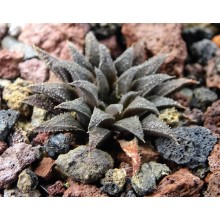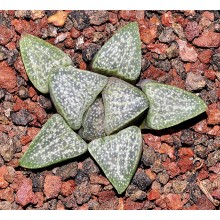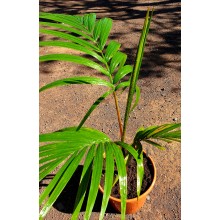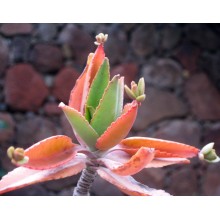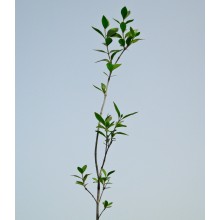Piante resistenti alla siccitá Ci sono 141 prodotti.

In questa sezione, raggruppiamo quelle piante che si adattano alle condizioni aride o di siccità. Normalmente, la maggior parte di queste specie, coltivate in condizioni di asciutto, sono cerosi, succulenti, pelosi, appiccicosi, aghiformi ed ancora più piccole rispetto al resto.
In Piante resistenti alla siccitá si possono trovare tutte le specie con queste caratteristiche: Pithecellobium dulce, Ruta graveolens, Syzygium cordatum, Tamarindus indica e così via.
-
Glottiphyllum oligocarpum
Glottiphyllum oligocarpum
This is a very attractive compact and blue glotty. Leaves are short and waxy and can look blue to grey. The flowers are so large that they cover the whole rosette.
12,00 € -
Graptopetalum filiferum
Graptopetalum filiferum
Rooted rosette. This graptopetalum with jade-green leaves is so compact that it resembles a Sempervivum. It is native to Chihuahua , in Mexico and flowers in Winter. It branches very slowly and will eventually fill the pot and form a solid mat.
23,20 € -
Haworthia attenuata 'Big Band'
Haworthia attenuata 'Big Band'
Supreme selection of the popular Haworthia fasciata. Big Band has white, prominent bands of dots. Leaves turn brown to black in high light, showing a beautiful black and white contrast!
10,40 € -
Haworthia attenuata 'Rainbow'
Haworthia attenuata 'Rainbow'
A supreme variegated clone of attenuata-radula, with different colour shades in each rosette.
12,70 € -
Haworthia glauca herrei
Haworthia glauca herrei
Beautiful Haworthia with glaucous leaves, native to the Eastern Cape, adapted to full sun. It is clumping and stem forming, so it will eventually form a large attractive specimen.
10,40 € -
Haworthia leightonii
Haworthia leightonii
This Haworthia forms large clumps and develops a bright red colour when stressed by sunlight. It was formerly classified Haworthia cooperi var leightonii and it is the easternmost population of the cooperi group.
17,60 € -
Haworthia x 'Cup of Gold'
Haworthia x 'Cup of Gold'
Haworthia ‘Cup of Gold’ is a Haworthia with pale yellow retuse leaves, possibly a selection or hybrid of H. otzeniana. Some people consider it variegated, though the variegation s just on the reverse of the leaves and it is not always evident.
10,80 € -
Hechtia tillandsioides
Hechtia tillandsioides
This is an unusual and elegant terrestrial bromeliad with spineless silvery leaves. Leaves are soft and velvety to touch. Established plants will bloom with huge "sprays" of pink flowers. Hechtia tillandsioides is native to Mexico (States of Hidalgo and Mexico). It takes frost and feels at home in Mediterranean climates !
21,50 € -
Hyophorbe indica 'Red'
Hyophorbe indica 'Red'
This palm is a great ornamental. It is very beautiful as a juvenile because of the reddish stem and petioles. They are very fast when young.
46,20 € -
Hyophorbe lagenicaulis - Bottle Palm
Hyophorbe lagenicaulis - Bottle Palm
h= 30-60 cm - Cont. 14-16 cm. Distinctive small palm, with a grey bottle-shaped trunk. Hyophorbe lagenicaulis has a waxy green crownshaft and elegant, arching pinnate leaves. Be careful, it is damaged or killed by frost, nevertheless it is a naturally short species that can live for years in a container.
62,30 € -
Kalanchoe suarezensis
Kalanchoe suarezensis
Beautiful, uncommon kalanchoe from Southern Madagascar with toothed margins. Leaves are grey green, with red margins, but they turn flaming red in full sun and cool weather.
12,60 € -
Kigelia africana - Sausage Tree
Kigelia africana - Sausage Tree
Large >2 years old plant - This African tree, produces distinctive gigantic fruits, shaped like sausages. It is easy to cultivate in pots, as long as it is kept above 4 C. Leaves are dark green, glossy and pinnate. The tree in fruit is a people-stopper.
42,00 € -
Lannea edulis
Lannea edulis
This species bears edible fruits and it grows just 20-50 cm tall. with a thick underground trunk or caudex, which helps it to survive drought and fires. Sometimes it is called the "underground tree".
92,30 € -
Lawsonia alba - Henna
Lawsonia alba - Henna
Henna is the most ancient dye, widely used from Northern Africa to India. It is a compact bushy tough shrub that can take frost to drought.
35,00 € -
Leptospermum scoparium - Manuka Tea Tree
Leptospermum scoparium - Manuka Tea Tree
Elegant evergreen shrub with deep green fragrant leaves that bears small flowers of white to pink in colour. It is resistant to moderate frost. This plant is called Manuka and it is known for medicinal purposes but also because it makes a special bee honey. There are also reports of therapeutic properties.
19,80 €
Al momento ci sono pochi prodotti in questa categoria Piante resistenti alla siccitá































